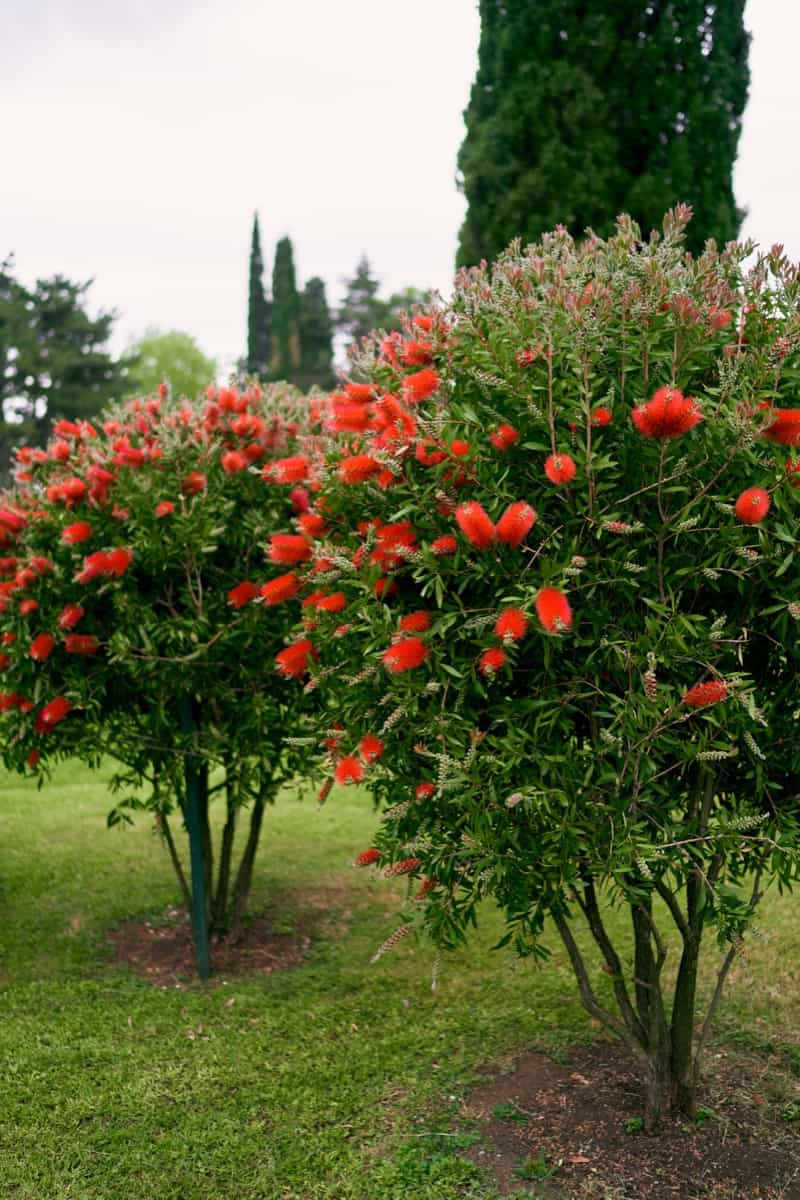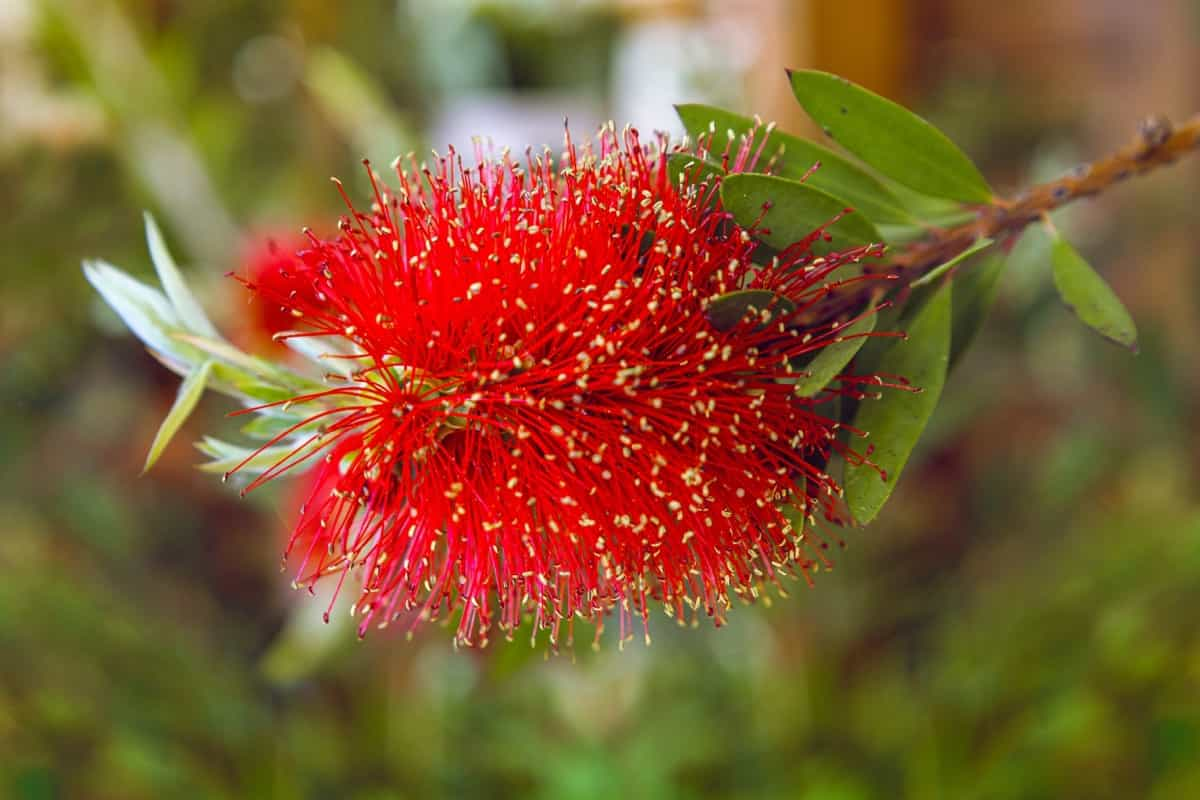Callistemon, also known as Bottlebrush. These beautiful shrubs and trees are native to Australia but can thrive in many different climates worldwide. These plants get their name from the unique flower shape resembling a bottle brush.

How to Plant and Care for Callistemon
Choosing the Right Soil and Location for Planting Callistemon
It is crucial to ensure healthy growth and blooming. Bottlebrush plants prefer slightly acidic to slightly alkaline soils, with a pH level of 6.0 to 8.0 on the pH scale. However, it’s always best to test your soil’s acidity before planting Callistemon. You can easily test your soil by purchasing a testing kit from a local gardening store or using a digital meter probe that measures the pH level accurately.
Bottlebrushes thrive in full sun exposure and well-draining soils. If you plan to plant multiple Callistemon shrubs, ensure enough space between each plant, as they can grow quite large over time. When preparing the soil for planting, mix some organic matter into the topsoil layer before placing your Callistemon shrub into its hole.
Growing Callistemon from Seeds: A Beginner’s Tutorial
- Growing Callistemon from seeds can be a rewarding experience for beginners. First, prepare a small pot with sandy soil mix or seed-starting mix. Moisten the soil and then scatter the seeds on top, gently pressing them down into the soil without covering them completely.
- Next, cover the pot with plastic wrap or a clear plastic bag to create a mini-greenhouse effect. Please place it in a sunny location but away from direct sunlight.
- After two weeks, remove the wrapping and check for any sprouts. If not, continue watering daily until germination occurs.
- Once they’ve grown their second set of leaves (usually after 4-6 weeks), transplant them into individual pots filled with well-draining potting soil.
Watering Schedule for Healthy Callistemon Growth
- Watering is a crucial aspect of caring for Callistemon plants. An adequate water supply ensures healthy growth and vibrant blooms. The watering schedule depends on various factors such as soil type, location, weather conditions, and plant age.
- Newly planted Callistemon requires frequent watering to establish roots. Water them deeply every 2-3 days during dry spells until they are established in their new environment. Once established, reduce the frequency to once every week or two weeks, depending on rainfall levels.
- During hot summer months, increase the frequency of watering to prevent dehydration. However, avoid overwatering as it can cause root rot and other related problems that affect plant health.
- In winter, when temperatures drop significantly, and there is less sunlight exposure due to shorter days, reduce watering frequency since the plants need less water at this time. When watering your Callistemon plants, always make sure not to wet foliage as it may lead to mildew or fungi growths which can weaken your plants’ overall health. Instead, use drip irrigation systems or a hose directly at its base for best results.
Caring for Callistemon Plants: Essential Tips for Success
- Watering: Water your Callistemon regularly, especially during hot and dry weather. However, avoid overwatering as it can lead to root rot.
- Pruning: Prune your Callistemon regularly to encourage bushier growth and more flowers. Cut back any dead or damaged branches and shape the plant according to your preference.
- Fertilizing: Apply a slow-release fertilizer to the plant in early spring before new growth appears. Avoid using high-nitrogen fertilizers, as they can promote excessive leafy development at the expense of flowers.
- Pests and Diseases: Watch for common pests such as scale insects, spider mites, and mealybugs. Treat any infestations promptly with insecticidal soap or neem oil. Also, watch out for fungal diseases such as powdery mildew and treat them with fungicides if necessary.
- Sunlight: Callistemon thrives in full sun but can tolerate partial shade. Provide 6 hours of direct sunlight daily for optimal blooming.
In case you missed it: How to Grow and Care for Persian Shield: Planting Instructions

Pruning Techniques for Shaping and Maintaining Callistemon Plants
- Pruning is an essential aspect of maintaining the health and shape of Callistemon plants. Proper pruning techniques will promote healthy growth, control the plant’s size, and enhance flowering.
- Prune after blooming finishes to avoid cutting off buds that will produce flowers next season.
- Use sharp, clean shears or a pruning saw to make cuts without damaging the plant. Regularly prune damaged or diseased wood throughout the year. Light trimming can be done anytime during the growing season, but heavy pruning should only be carried out in winter while it is dormant.
Fertilizing Callistemon: Best Practices for Optimal Blooming
- Fertilizing is an essential part of caring for Callistemon plants. Use a slow-release fertilizer formulated specifically for flowering shrubs in early spring and again in mid-summer. Be sure not to over-fertilize, as this can lead to excessive foliage development at the expense of blooms.
- Fertilizing Callistemon is crucial for its optimal blooming. The best time to fertilize your Callistemon plant is during the growing season, which usually spans spring through summer.
- Before applying any fertilizer, it’s important to understand the nutritional needs of Callistemon plants. They require a balanced fertilizer that contains equal amounts of nitrogen, phosphorus, and potassium.
- It’s also recommended to opt for slow-release fertilizers as they provide a steady supply of nutrients over an extended period. This ensures that your plant receives adequate nourishment without overfeeding or underfeeding it.
- When applying fertilizer, always follow the instructions provided by the manufacturer carefully. Over-fertilization can lead to burnt foliage and stunted growth, while under-fertilization can result in poor blooming and weak stems.
- Avoid feeding your Callistemon plant with high-nitrogen fertilizers, as they encourage vegetative growth at the expense of blooms. Instead, use a bloom booster fertilizer specifically designed for flowering plants.
Overwintering Callistemon: Cold Weather Care and Protection
- While Callistemon is a hardy plant, protecting it during the colder months of the year is important. One way to do this is by mulching around the base of the plant with leaves or straw, which will help insulate its roots and retain moisture.
- Another option is to cover your Callistemon with burlap or a frost cloth on cold nights. This will provide extra protection against harsh winter winds and frost.
- It’s also important to avoid overwatering your Callistemon during winter, as too much water can lead to root rot when temperatures drop. Instead, only water when the soil feels dry to the touch.
- If you live in extremely low temperatures, consider growing your Callistemon in a pot or container that can be brought indoors during winter.
Protecting Callistemon from Common Pests and Diseases
- One common pest that can affect Callistemon is the scale insect. These small, oval-shaped insects feed on the plant’s sap and can cause yellowing plant leaves and stunted growth. To prevent infestations, regularly inspect your plants for scale insects and remove them by hand or with a soapy water spray.
- Another issue is fungal diseases such as rust or powdery mildew. These diseases thrive in humid conditions, so space out your Callistemon plants for adequate air circulation. If you notice any signs of these fungal diseases, promptly remove infected leaves or branches and treat them with a fungicide.
- Spider mites can also be problematic for Callistemon plants. These tiny arachnids suck the sap from leaves, causing them to appear stippled or discolored. They thrive in hot, dry conditions, so regular misting can help prevent their infestation.
In case you missed it: How to Grow and Care for Japanese Maple: Planting Instructions

Conclusion
Caring for Callistemon plants is essential to ensure their healthy growth and blooming. Callistemon is a beautiful and vibrant plant that can add color to any garden or landscape. Growing and caring for this plant requires minimal effort but yields great results.
- Feed Your Flock for Less: Top 10 Tips to Save on Chicken Feed
- Ultimate Guide to Ossabaw Island Hog: Breeding, Raising, Diet, and Care
- Hatching Answers: The Top 10 Reasons Your Chickens Aren’t Laying Eggs
- Eggs and Economics: Breaking Down the Cost of Raising Backyard Chickens
- Defend Your Greens: Proven Methods to Keep Iguanas Out of Your Garden
- Ultimate Guide to Cinnamon Queen Chicken: A Comprehensive Guide for Beginners
- Ultimate Guide to California Tan Chicken: Breeding, Raising, Diet, Egg-Production and Care
- Ultimate Guide to Marsh Daisy Chicken: Breeding, Raising, Diet, and Care
- 10 Types of Chicken Farming Businesses You Can Start for Profits